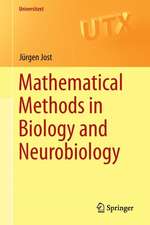Introduction to Mathematics for Life Scientists: Springer Study Edition
Autor Edward Batscheleten Limba Engleză Paperback – oct 1979
Din seria Springer Study Edition
-
 Preț: 386.26 lei
Preț: 386.26 lei -
 Preț: 370.79 lei
Preț: 370.79 lei -
 Preț: 296.06 lei
Preț: 296.06 lei -
 Preț: 403.37 lei
Preț: 403.37 lei - 23%
 Preț: 921.30 lei
Preț: 921.30 lei -
 Preț: 403.37 lei
Preț: 403.37 lei -
 Preț: 389.70 lei
Preț: 389.70 lei - 15%
 Preț: 502.73 lei
Preț: 502.73 lei -
 Preț: 389.70 lei
Preț: 389.70 lei - 5%
 Preț: 1122.94 lei
Preț: 1122.94 lei - 5%
 Preț: 370.38 lei
Preț: 370.38 lei -
 Preț: 406.25 lei
Preț: 406.25 lei - 15%
 Preț: 530.58 lei
Preț: 530.58 lei -
 Preț: 398.35 lei
Preț: 398.35 lei - 5%
 Preț: 368.73 lei
Preț: 368.73 lei - 15%
 Preț: 633.02 lei
Preț: 633.02 lei -
 Preț: 392.75 lei
Preț: 392.75 lei - 15%
 Preț: 588.69 lei
Preț: 588.69 lei - 20%
 Preț: 660.99 lei
Preț: 660.99 lei - 20%
 Preț: 663.61 lei
Preț: 663.61 lei - 15%
 Preț: 640.88 lei
Preț: 640.88 lei - 15%
 Preț: 654.43 lei
Preț: 654.43 lei -
 Preț: 390.46 lei
Preț: 390.46 lei - 15%
 Preț: 652.81 lei
Preț: 652.81 lei -
 Preț: 394.87 lei
Preț: 394.87 lei - 15%
 Preț: 642.03 lei
Preț: 642.03 lei - 15%
 Preț: 688.99 lei
Preț: 688.99 lei - 15%
 Preț: 642.36 lei
Preț: 642.36 lei - 15%
 Preț: 635.15 lei
Preț: 635.15 lei -
 Preț: 396.62 lei
Preț: 396.62 lei - 18%
 Preț: 893.21 lei
Preț: 893.21 lei -
 Preț: 419.14 lei
Preț: 419.14 lei -
 Preț: 423.34 lei
Preț: 423.34 lei - 20%
 Preț: 377.27 lei
Preț: 377.27 lei - 18%
 Preț: 742.97 lei
Preț: 742.97 lei - 15%
 Preț: 655.27 lei
Preț: 655.27 lei - 20%
 Preț: 336.02 lei
Preț: 336.02 lei -
 Preț: 397.38 lei
Preț: 397.38 lei
Preț: 508.91 lei
Nou
Puncte Express: 763
Preț estimativ în valută:
97.38€ • 104.13$ • 81.19£
97.38€ • 104.13$ • 81.19£
Carte tipărită la comandă
Livrare economică 18 aprilie-02 mai
Preluare comenzi: 021 569.72.76
Specificații
ISBN-13: 9783540096481
ISBN-10: 3540096485
Pagini: 668
Ilustrații: XV, 646 p.
Dimensiuni: 155 x 235 x 35 mm
Greutate: 0.92 kg
Ediția:3rd ed. 1979
Editura: Springer Berlin, Heidelberg
Colecția Springer
Seria Springer Study Edition
Locul publicării:Berlin, Heidelberg, Germany
ISBN-10: 3540096485
Pagini: 668
Ilustrații: XV, 646 p.
Dimensiuni: 155 x 235 x 35 mm
Greutate: 0.92 kg
Ediția:3rd ed. 1979
Editura: Springer Berlin, Heidelberg
Colecția Springer
Seria Springer Study Edition
Locul publicării:Berlin, Heidelberg, Germany
Public țintă
Lower undergraduateCuprins
1. Real Numbers.- 1.1 Introduction.- 1.2 Classification and Measurement.- 1.3 A Problem with Percentages.- 1.4 Proper and Improper Use of Percentages.- 1.5 Algebraic Laws.- 1.6 Relative Numbers.- 1.7 Inequalities.- 1.8 Mean Values.- 1.9 Summation.- 1.10 Powers.- 1.11 Fractional Powers.- 1.12 Calculations with Approximate Numbers.- 1.13 An Application.- 1.14 Survey.- Problems for Solution.- 2. Sets and Symbolic Logic.- 2.1 “New Mathematics”.- 2.2 Sets.- 2.3 Notations and Symbols.- 2.4 Variable Members.- 2.5 Complementary Set.- 2.6 The Union.- 2.7 The Intersection.- 2.8 Symbolic Logic.- 2.9 Negation and Implication.- 2.10 Boolean Algebra.- Problems for Solution.- 3. Relations and Functions.- 3.1 Introduction.- 3.2 Product Sets.- 3.3 Relations.- 3.4 Functions.- 3.5 A Special Linear Function.- 3.6 The General Linear Function.- 3.7 Linear Relations.- Problems for Solution.- 4. The Power Function and Related Functions.- 4.1 Definitions.- 4.2 Examples of Power Functions.- 4.3 Polynomials.- 4.4 Differences.- 4.5 An Application.- 4.6 Quadratic Equations.- Problems for Solution.- 5. Periodic Functions.- 5.1 Introduction and Definition.- 5.2 Angles.- 5.3 Polar Coordinates.- 5.4 Sine and Cosine.- 5.5 Conversion of Polar Coordinates.- 5.6 Right Triangles.- 5.7 Trigonometric Relations.- 5.8 Polar Graphs.- 5.9 Trigonometric Polynomials.- Problems for Solution.- 6. Exponential and Logarithmic Functions I.- 6.1 Sequences.- 6.2 The Exponential Function.- 6.3 Inverse Functions.- 6.4 The Logarithmic Functions.- 6.5 Applications.- 6.6 Scaling.- 6.7 Spirals.- Problems for Solution.- 7. Graphical Methods.- 7.1 Nonlinear Scales.- 7.2 Semilogarithmic Plot.- 7.3 Double-Logarithmic Plot.- 7.4 Triangular Charts.- 7.5 Nomography.- 7.6 Pictorial Views.- Problems for Solution.- 8. Limits.- 8.1Limits of Sequences.- 8.2 Some Special Limits.- 8.3 Series.- 8.4 Limits of Functions.- 8.5 The Fibonacci Sequence.- Problems for Solution.- 9. Differential and Integral Calculus.- 9.1 Growth Rates.- 9.2 Differentiation.- 9.3 The Antiderivative.- 9.4 Integrals.- 9.5 Integration.- 9.6 The Second Derivative.- 9.7 Extremes.- 9.8 Mean of a Continuous Function.- 9.9 Small Changes.- 9.10 Techniques of Integration.- Problems for Solution.- 10. Exponential and Logarithmic Functions II.- 10.1 Introduction.- 10.2 Integral of 1/x.- 10.3 Properties of ln x.- 10.4 The Inverse Function of ln x.- 10.5 The General Definition of a Power.- 10.6 Relationship between Natural and Common Logarithms.- 10.7 Differentiation and Integration.- 10.8 Some Limits.- 10.9 Applications.- 10.10 Approximations and Series Expansions.- 10.11 Hyperbolic Functions.- Problems for Solution.- 11. Ordinary Differential Equations.- 11.1 Introduction.- 11.2 Geometric Interpretation.- 11.3 The Differential Equation y’ = ay.- 11.4 The Differential Equation y’ = ay+b.- 11.5 The Differential Equation y’ = ay2+ by+ c.- 11.6 The Differential Equation dy/dx = k · y/x.- 11.7 A System of Linear Differential Equations.- 11.8 A System of Nonlinear Differential Equations.- 11.9 Classification of Differential Equations.- Problems for Solution.- 12. Functions of Two or More Independent Variables.- 12.1 Introduction.- 12.2 Partial Derivatives.- 12.3 Maxima and Minima.- 12.4 Partial Differential Equations.- Problems for Solution.- 13. Probability.- 13.1 Introduction.- 13.2 Events.- 13.3 The Concept of Probability.- 13.4 The Axioms of Probability Theory.- 13.5 Conditional Probabilities.- 13.6 The Multiplication Rule.- 13.7 Counting.- 13.8 Binomial Distribution.- 13.9 Random Variables.- 13.10 The Poisson Distribution.- 13.11Continuous Distributions.- Problems for Solution.- 14. Matrices and Vectors.- 14.1 Notations.- 14.2 Matrix Algebra.- 14.3 Applications.- 14.4 Vectors in Space.- 14.5 Applications.- 14.6 Determinants.- 14.7 Inverse of a Matrix.- 14.8 Linear Dependence.- 14.9 Eigenvalues and Eigenvectors.- Problems for Solution.- 15. Complex Numbers.- 15.1 Introduction.- 15.2 The Complex Plane.- 15.3 Algebraic Operations.- 15.4 Exponential Functions of Complex Variables.- 15.5 Quadratic Equations.- 15.6 Oscillations.- Problems for Solution.- Appendix (Tables A to K).- Solutions to Odd Numbered Problems.- References.- Author and Subject Index.
















